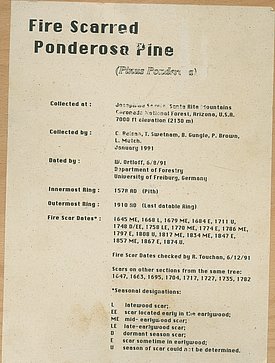Ponderosa pine, a typical species in the southwestern United States, is quite fire resistant. In older trees, surface wildfires only damage the stems. Wounds are overgrown after each fire. Based on their scars, scientists can reconstruct the fire history of a forest to the exact season.
When human history is revealed in tree rings
Until the late 19th century, wildfires caused by lightning strikes occurred in the dry ponderosa pine forests in the USA every 5 to 25 years. These fires were mostly superficial and mainly destroyed grasses, shrubs and young trees. High-intensity crown fires were rare, since little fuel built up on the ground.
After 1874, the US Forest Service started suppressing fires. As a result, more young trees grew, competing with older trees for water and nutrients. After this date, the tree rings on this stem became narrower, and no fire scars are visible.
Charred but precious archives ¶
The exhibited disc was researched in 1991 in Tucson, Arizona. Its fire scars were documented in order to reconstruct the fire history of the sampling site.
Whenever a fire could be dated exactly to the season, this was indicated by letters as seen on the document to the right (EE, LE, E, ME, etc.).
Earlywood is produced at the beginning of the growing season.

